|
"From Haus Wachenfeld to
the Berghof"
Adolf Hitler's Home on the
Obersalzberg, 1927-1945
Part 2 -- the Berghof,
1936-1952
To befit the head of state of a
rapidly emerging world power country, plans were made to remodel Haus Wachenfeld in 1935.
The 1936 work actually involved a total conversion, with large masonry additions of a main
house and added wing, and an enlarged garage. Further work took place in 1938.
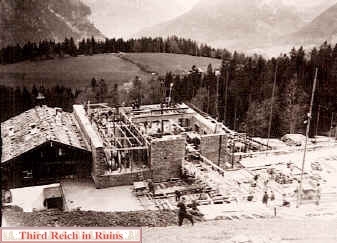
|
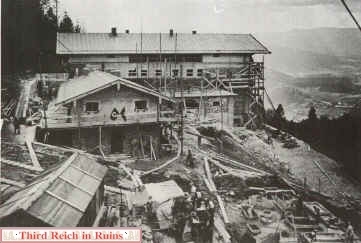
|
Haus
Wachenfeld during its conversion into the Berghof, ca. June 1936. The west side of Haus
Wachenfeld was retained, and the main part of the Berghof was simply added onto this. (U.S.
National Archives RG 242-HB, 22443-22) |

|

|
These
colorized versions of period photos show how the Berghof was built around Haus Wachenfeld,
retaining the west side of the original house. In the view on the left, the large picture
window has been lowered into the basement. (from postcards in author's
collection) |

|

|
These
period color postcards show how Haus Wachenfeld with its small terrace (on the left) was
incorporated into the Berghof, with its enlarged terrace added to the front and side, over
the larger garage. Hitler's native Austria is visible in the middle distance, through the
cleft in the mountains. (author's collection) |

|

|
After
the initial 1936 reconstruction was finished, the eastward extension of the house was only
about half as long as it eventually became. This part of the Berghof housed the kitchen,
dining hall, and quarters and working areas for the staff. The view on the right shows the
1939 completed extension, with its auxiliary driveway allowing deliveries direct to the
kitchen area. (postcards in author's collection) |

|

|
The
eastern part of the house was extended until it came almost beneath the Hotel
zum Türken.
The view on the left, from Martin Bormann's house, shows a good picture of the layout of
these Obersalzberg buildings. Bormann's house overlooked both
the Türken and the Berghof, so he could oversee the comings and
goings of the RSD and Hitler's entourage. (left - from "Hitler in seinen
Bergen," 1938 ed.; right - period postcard; both in author's collection) |
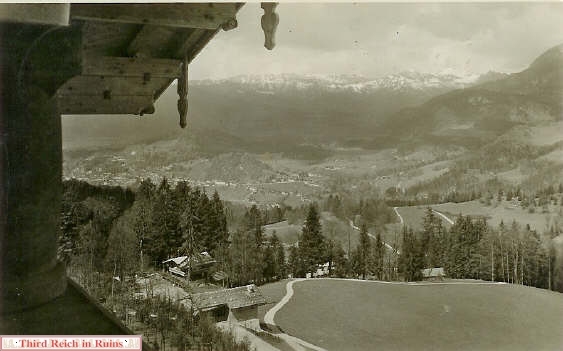
|
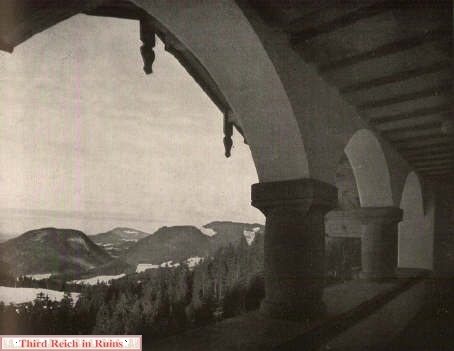
|
Two views
from the
covered balcony on the second floor of the Berghof (what Americans would call the third
floor). In the view on the left, the main SS guard house can be seen near
the bottom of the view. This balcony was outside the guest room called the
Untersbergzimmer, so-named due to the room's spectacualr view of
the Untersberg mountain (see also the room view further down on this
page). (left - period postcard; right - from "Hitler abseits vom Alltag" by Heinrich Hoffmann,
Berlin, 1937) |

|

|
These
two views were taken from down off the hill in front of the house.
The wooden walkway that made its way down this hillside was the beginning of the path for
Hitler's daily walk to the Mooslahnerkopf Teehaus.
(left - U.S. National Archives, RG242EB-11-11A; right - courtesy Harry
von Gebhardt) |

|

|
The
grand staircase led from the driveway to the Berghof entrance. This staircase was the
scene of many famous photos, showing Hitler's visitors such as Mussolini, the Duke and
Duchess of Windsor, Neville Chamberlain, and other national leaders, diplomats, and
military figures. This is a post-war view dating probably from the summer of 1945. The
wooden door in the distance in the right-hand photo led to a film projection room, for
showing films in the Great Room. The open doorway was the entrance to the Berghof itself,
directly behind the photographer's standpoint. (left - U.S. Army photo; right -
U.S. National Archives RG 242-EB) |
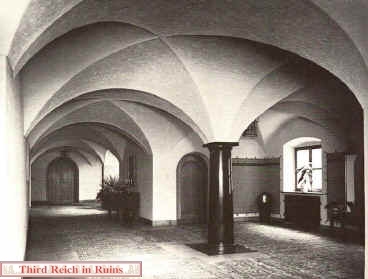
|

|
| The exterior doorway
opened into a vaulted corridor, from which one entered the Great Room, or went up the
steps to the upper floors. In the left-hand photo, the door at the far end led into the
Berghof dining hall. The door into the Great Room opened in the left-hand wall. The door in
the center of the photo led into a men's lavatory. The stairway seen in the right-hand
photo led to the right just before the far doorway in the left-hand photo. (National
Archives RG 242-EB) |
-

|

|
The
doorway shown in these photos led off the corridor into the Great Room of the Berghof,
which Hitler used as a reception and conference room. This room was lavishly decorated
with Persian carpets, Gobelin tapestries, and original paintings and sculptures. These
views show the right-rear corner of the room and the east wall; the large picture window
is behind the viewer, and the marble fireplace is just out of view to the right, on the
back (south) wall. The Gobelin tapestry on the east wall was removed to uncover the film
projection openings, and the tapestry on the opposite wall was removed to use the wall
behind as a screen. (photo on left from a period postcard; photo on right from
"Hitler abseits vom Alltag" by Heinrich Hoffmann, Berlin, 1937 (both in author's
collection) |

|
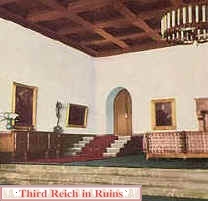
|

|
| Further views of the
east side and rear of the Berghof Great Room, from period postcards. (author's
collection) |

|
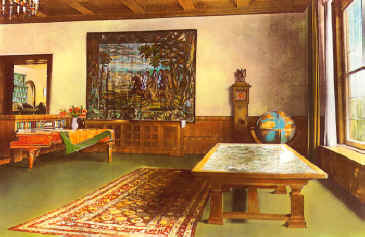
|
Continuing
around the Great Room, the doorway in the west side wall led into the living area of Haus Wachenfeld. The Gobelin tapestry
was removed to use the wall as a screen for film showings. (period postcards in
author's collection) |
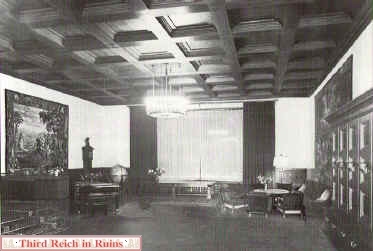
|

|
Completing
the circuit around the Great Room led to the front (north) wall with its famous grand
picture window. This window could be lowered into the basement, giving an open view of the
mountains. (left - National Archives RG 242-H; right - period
postcard) |

|
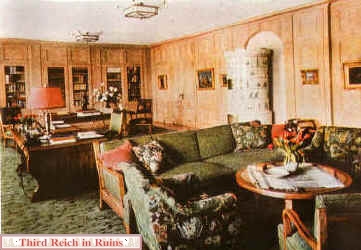
|
Two
views of Hitler's office on the first floor of the Berghof (second floor to
Americans). (period postcards) |

|

|
Two
views of the sun room in the Berghof (the old "wintergarten" of Haus
Wachenfeld). (period postcards) |

|

|
On the
left, a view of the "Untersberg Room," complete with Bavarian tile Kachelofen.
This room, on the upper floor above Hitler's office, was used by
Deputy Führer Rudolf Hess. Other such rooms were occupied by Hitler's secretaries and a few close guests, mainly
Eva Braun's friends (diplomatic guests were housed in Villa Bechstein or the Gästehaus Hoher
Göll on the Obersalzberg, or the Berchtesgadener Hof in town, or the Kleßheim Palace in
Salzburg). On the right, the Berghof dining room, with its decorative cembra
pine paneling (Swiss stone pine). The
dining room was located in the eastern extension of the Berghof building.
Hitler sat in the middle of the table on the right, facing the windows and
the view of the Untersberg mountains. (period
postcards in author's collection) |

|

|
The
original version of this colorized (and cropped) postcard identifies this
room as simply a Berghof guest room. It is sometimes identified today as Eva
Braun's living room (although there was no such "living room" in the
Berghof), but it actually served as Gretl Braun's bedroom (called the Türkenzimmer
because of its view of Haus Türken). Some sources say the painting on
the wall represented Eva, perhaps with her face painted onto a model's
body by artist Adolf Ziegler. However, this original painting still
exists, and the face doesn't really resemble Eva (or Gretl either). (left
- period postcard; right - National Archives RG242) |

|

|
A few
of Hitler's visitors at the Berghof -- on the left, a visit on the terrace
from the Goebbels family (the woman in the center is Heinrich Hoffmann's wife Erna). On
the right, the Great Room was the scene for the Leibstandarte's congratulations on
Hitler's 55th birthday in 1944, presented by SS-Obersturmbannführer Max Wünsche,
commander of SS-Panzerregiment 12 "Hitler Jugend." Wünsche and Hitler shared
the same birthday, April 20, and Wünsche had previously been one of Hitler's personal
aides. SS chief Heinrich Himmler looks on. Click here
to see a page with other Berghof visitors. (photo on left from "Hitler
abseits vom Alltag" by Heinrich Hoffmann, Berlin, 1937; on right, U.S.
National Archives RG 242H) |
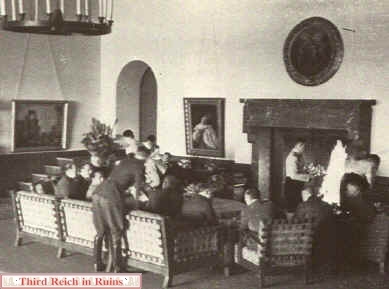
|

|
A
military staff conference in front of the fireplace. The western side of the Berghof was
an Adjutancy building, where many of Hitler's military staff and personal adjutants
worked
while he was on the Obersalzberg. Thus, they were always immediately available for
conferences or consultation. (left - from Heinrich Hoffmann, "Hitler Was My
Friend" (London, 1955); right - period postcard) |
 |
 |
 |
| Details
of the Berghof fireplace in the Great Room. The fireplace was of red
marble from the Untersberg mountains (visible just across the valley in
front of the Berghof), with interior panels dated 1928 (the date Hitler
moved into Haus Wachenfeld) and 1936 (the date the Berghof was
constructed). The panel on the left (1928) showed a farmer sewing seed,
while that on the right (1936) showed a Lederhosen-clad man with a
scythe. The close-up views above were taken in 1945, before the
fireplace had been completely stripped by souvenir hunters. (left, center
- author's collection; right - period postcard) |

|

|
On
the left, Gretl Braun (Eva's sister) and an unidentified friend stand on the terrace on the
west side of the Berghof, in front of the side wing building that formed
part of the Adjutancy. On the right, EB suns herself while Hanni Morrell
and another friend join her on the main Berghof terrace, above the
garage. Below, EB and Henriette von Schirach on the steps in front of the
Adjutancy wing, leading down beside the garage. (U.S. National Archives, Hoffmann Collection)
Click here to visit a page identifying other visitors to the
Berghof.
|
 |
"Bormann's Tree"
|

|

|
|
Before the outbreak of World
War II, Hitler often greeted crowds of visitors to Haus Wachenfeld and
the Berghof from
the end of his driveway, either standing in the drive or on the
retaining wall next to the road. These public "march past"
reviews often lasted for hours, and in June 1937 Hitler complained to
Martin Bormann about the lack of shade on the hot summer days. Bormann
immediately procured a mature linden tree from Munich and had it
planted near the end of the driveway.
The photo on the left above shows
Hitler greeting the crowds at the
end of the Berghof driveway - this location would later be
shaded by the linden tree. The photo on the right shows the
linden tree at the end of the main Berghof driveway (triangular-shaped tree
without leaves). (left - Heinrich Hoffmann,
"Hitler in seinen Bergen," Munich, 1938; right - period
postcard)
I have seen a couple period
photos showing Hitler actually standing beneath Bormann's Tree, but I
was unable to procure them for this webpage. If anyone would like to
donate a good copy of such a view for this page, I'd be obliged (walden01(at)comcast.net).
The photo on the left below shows Hitler and his entourage walking down the main
drive, with the Bormann Tree seen at the right edge (the trunk was
protected by a wrapping). On the right, Hitler greets a group of older
BdM girls (probably a "Glaube und Schönheit" group) from
the Berghof terrace. Bormann's Tree can be seen in the
background. (left - photo donated; right - courtesy
Harry von Gebhardt)
|
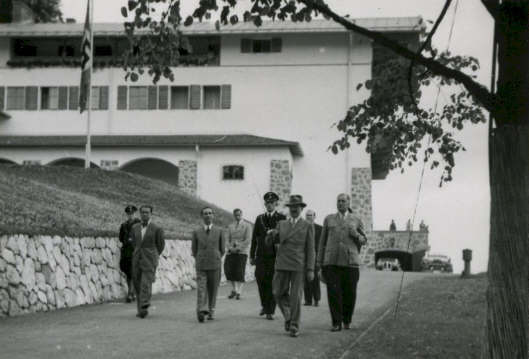
|

|
 |
 |
| Further
views of Bormann's Tree, also showing the details of the east wing of
the Berghof. (left - period postcard in author's collection;
right - "Ich kämpfe," Munich, 1943) |

A view of Bormann's Tree (not leafed
out) from an SS soldier's photo album, ca. 1938.
|

|

|
|
These two U.S. Army photos
show the Bormann Tree in 1945. On the left, GIs from the U.S. 3rd Infantry
Division capture the Berghof on 4 May 1945 - the blasted remains of
the Bormann Tree can be seen at the left. On the right, GIs touring
the ruins in the summer of 1945 pass near the Bormann Tree,
stripped bare of its leaves. (US National Archives, RG 111-SC, left
- #204347-S)
|
|

|

|
|
On the left, a GI guards
the Berghof ruins in the summer of 1945 - the Bormann Tree is
beginning to recover. When my father visited the
site in early 1946 (right), the Bormann Tree was beginning to look like
a healthy tree again. (left - US National Archives; right -
G.A. and G.R. Walden collection)
|
|

|

|
|
These views show the Bormann
Tree fully leafed out again. On the right, dignitaries visit the Berghof ruin
later in 1946. The Bormann Tree has a sign tacked
onto it which reads EINTRITT FÜR ZIVIL VERBOTEN (Entry for Civilians
Forbidden ... meaning German civilians). (left - period
postcard in author's collection; right - US National Archives, RG 111-SC)
|
|

|

|
|
The Bormann Tree survived the
1952 destruction of the Berghof ruins - it can still be seen shading
the end of the driveway in the photos above, taken 1955-1960,
after the destruction and burial of the Berghof ruins (the rebuilt
Hotel zum Türken is at the upper left of the aerial view). The tree survived until at
least 1964 but was cut down at some point; however, its remains can still be seen as shoots growing up from
the original location near the end of the driveway - in the recent photo below, the linden tree shoots are just leafing out in the left-center
of the photo. (left
- postcard in author's collection; right - UPI, 20 April 1955) ("Bormann Tree" story and details thanks to Guy Dartois and
Ralf Hornberger)
Note: Clean-up efforts along the
mountain roadways occasionally result in cutting down these shoots,
but so far they have always grown back.
|

|
Destruction of the Berghof, 1945-1952

The Berghof was heavily damaged during the RAF
bombing raid on 25 April 1945. This photo, taken
from a Lancaster bomber during the raid, shows most of the main Obersalzberg complex. The
Berghof
appears at the bottom, showing at least three direct bomb hits. (Royal Air Force
photo, Hotel zum Türken)

This aerial reconnaissance photo taken
shortly after the bombing shows the damage to the immediate Berghof area. The
east wing
suffered a direct hit, another bomb hit just outside the main entrance, and a
third hit between the Adjutancy and the Haus
Wachenfeld part.
A bomb scored a direct hit on
the Hotel zum Türken next door, and the Kindergarten building was also hit.
Note the huge crater in the hillside
behind the Berghof
east wing - from a Tallboy or Blockbuster bomb. This crater can still be seen
there today. (U.S. National Archives)

|

|
Departing SS troops
set the Berghof on fire on 4 May 1945, burning away the wooden parts and
severely damaging the rest of the building. The ruins were still smoldering when
soldiers of the U.S.
Army 3rd Infantry Division arrived that afternoon. Note the the snow remaining from a light snowfall the night before. (U.S. Army photos, National Archives RG 111-SC 204347-S,
204344-S) |

GIs of the U.S. 3rd Infantry Division, the first
Allied troops to arrive on the Obersalzberg (7th Infantry Regiment), haul down the
swastika flag from in front of the smoldering Berghof. (Contrary to what you read in
several books today (Stephen Ambrose's Band of Brothers is the best known example),
the 101st Airborne Division were not the first Allied troops to reach Berchtesgaden
or the Obersalzberg. However, it is possible that a vehicle or two from the Free
French unit "Régiment de Marche du Tchad" were actually the first
Allied soldiers to reach Berchtesgaden, and perhaps the Obersalzberg; however,
if so, they did not stay but drove away and returned later as part of the Allied
occupation force. Click here
to read the story of the first Allied tank (French) to reach the Obersalzberg.) (U.S. Army photo, National Archives RG 111-SC
205102)

|

|
On the
left, a view taken from the hill behind the Berghof,
shows the burned-out ruin as it was found by the 3rd Infantry Division
soldiers. On the right is a photo taken on 4 or 5 May 1945 by Major Lloyd Ramsey
of the U.S. 7th Infantry Regiment on the Berghof garage terrace, showing
smoke issuing from the Berghof grand window. (left - Rupert
Prohme, "History of 30th Infantry Regiment World War
II," Washington, Infantry Journal Press, 1947; right - Lloyd Ramsey
Collection, World War History & Art Museum) |

|

|
These two photos from
Yank - The Army Weekly (22 June 1945) show the ruins of the Berghof from the
conquerors' perspective. On the left, the still-smoldering ruins as seen from the terrace
of the Hotel Zum Türken; on the right, GIs from the 3rd Infantry Division enjoy the
Berghof stores of wine and cognac. They are sitting at the top of the grand staircase,
just outside the Berghof entrance. ("Yank," 22 June
1945; U.S. Army Signal Corps Collection, National Archives) |
Click here to visit a page
showing souvenirs taken home by GIs who visited the Berghof site in 1945.
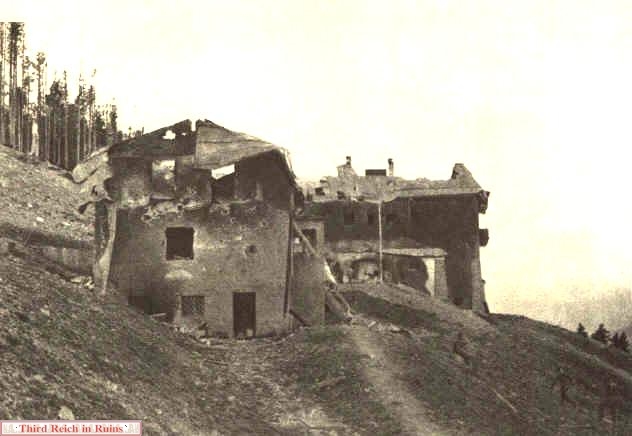
Soldiers of the 101st Airborne Division arrived
the day after the 3rd Infantry Division. In this May 1945 photo,
it appears that someone has been taking pot-shots at the side of the Berghof. (from
"The Epic of the
101st Airborne," 101st Airborne Division Public Relations Office, Auxerre, France,
1945)

|

|
|
The Berghof dining wing following
the occupation, exterior and interior views of the ruins. (left -
courtesy Ray Northcott; right - Life Collection)
|
 |
 |
| Above,
and below left - photos taken shortly after the end of the war by
American and French soldiers. Much of the tin roof remained in May 1945,
but was quickly plundered. The postcard view below right shows the
appearance of the Berghof ruins ca. 1950. |
 |
 |

This photo, taken by a U.S. soldier
shortly after the end of World War II, shows a view not normally seen of the
Berghof ruins,
from behind the 1938 extension of the eastern wing. Details of the windows and
doorways in this wing are clearly visible,
as is the smoke staining coming out of some windows, showing that this wing was
also involved in the fire of 4 May 1945.
The missing part of the front side of the roof on this wing was a result of a
direct bomb hit on 25 April 1945. (author's collection)

|
American soldiers walk toward the ruins of the Berghof during a visit in
May 1945. The devastation from the bombing attack of the month before is
obvious. Huge bomb craters had obliterated the Obersalzberg road in
places, trees were blasted, and the very ground was churned up.
(U.S. National Archives, RG342H-A49859) |
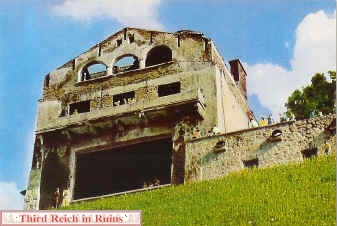
|

|
| Appearance of the ruined
Berghof in the late 1940s - early 1950s. The dangling remains of the tin roof, seen in the
previous photos, have been removed. Some said that the smoke and weather stains on the
side of the house resembled a grinning skull (see photo on right, and just
below). (author's
collection) |

|

|
The
view on the left, taken from the ruins of Bormann's house, shows the retaining wall in the
back of the Berghof, which is all that remains aboveground today. (author's
collection) |
 |
 |
| This
series of photos showing the ruins of the Berghof was taken in 1949 by a
visiting American soldier. These views show either end of the eastern
wing of the house - a large section of damage from a direct bomb hit
separated these parts of the ruin. (Westfield Athenaeum
Collection, courtesy Frank Tompkins) |
 |
 |
| On the
left, the visitors are standing in the doorway to the basement of the
eastern wing, which was for deliveries to the storerooms and kitchen.
They then proceeded inside, where they found this oven and other kitchen
furnishings. (Westfield Athenaeum Collection, courtesy Frank
Tompkins) |
 |
 |
| These
views show the western side of the Berghof, where Haus Wachenfeld had
been. When the retreating SS staff set fire to the ruins on 4 May 1945,
the wooden parts of the Haus Wachenfeld wing were burned away, leaving
the brick and masonry foundations. The large doorway seen in these
photos opened from a second floor hallway (first floor in German usage)
in Haus Wachenfeld into the hallway in the Berghof second floor that
held the doorways into Hitler's office, Eva Braun's bedroom, and storage
rooms. (Westfield Athenaeum Collection, courtesy Frank Tompkins) |

|

|
The
Berghof ruins looked like this when these color slides were made about
1950.
The original wooden doors were still on the garage. (photos by
Col. John J. Tarsitano, courtesy Nancy Tarsitano Drake) |

|

|
The
Berghof ruins in early 1952, shortly before their demolition. The sign
read "Keep Out, Building Unsafe, No Unauthorized
Admittance." ("Illustrated London News," 5 January
1952) |

|

|
To
deter tourists, sight-seers, and neo-Nazis, the Bavarian government blew up the ruins of
the Berghof on 30 April 1952, the anniversary of Hitler's death. The garage remained after
the 1952 destruction, but was removed in 1995, after the U.S. Army turned the Obersalzberg
area back over to Bavaria. (postcards in author's collection) |
 |
 |
| The ruin
of the Berghof garage as it appeared in the 1980s. For many years after
the main house ruins were demolished in 1952, the garage could still be
seen on the hillside above the road that originally led to the Berghof
(compare to the postcard view above, from a slightly different angle).
The view of the garage front below can be compared to a photo taken
during construction of the Berghof. (below left - U.S. National
Archives, RG 242HB-22443-18; many thanks to David Dionne for the modern
photos) |
 |
 |
 |
 |
| Two more
views of the garage remains in 1983 (left) and 1992 (right). The view on
the left shows the top of the original doorway into the garage (most of
the opening was blocked by rubble). The garage interior can be seen on
the right. The garage ruin was torn down in 1995, but many of the stones
were saved and used during the construction of the Wegmacher Kapelle
wayside chapel, north of Berchtesgaden (below). (above -
courtesy David Dionne) |
 |
 |
The Berghof
Site Today
 |
 |
| Remains of the Berghof
site as it appears today. On the left, the site seen from the terrace of the
Hotel
zum
Türken (compare to the 1945 Yank photo).
(To get an idea of the size of the Berghof, the eastern wing of the
building extended all the way out down the secondary drive seen here, to
the point where the drive no longer appears rough (where it is covered
by fill today), but turns smooth (this is the original drive surface) -
almost to a point just beneath the Türken.) When the Hotel General Walker
(former Platterhof) was torn down in 2000, debris was dumped at the top of the Berghof
driveway areas. This and previous fill and debris has raised the ground
level across much of the Berghof site, several feet higher than the
original level. In July 2008 an interpretive marker was finally placed at the
Berghof site, the historical significance of which had been ignored since
1952. (MapQuest
Map Link) |
 |
 |
| The
Berghof main driveway (entrance seen on the left) has been mostly
covered by fill, and trees have grown up all over the site. The photo on
the right shows the site of the Berghof garage, which was demolished in
1995. Traces of the foundation at the front can be seen (compare to the
construction photo and post-1952 photo of the garage ruin above). |
 |
 |
| All
above-ground remains of the house have been removed from the site or
buried (parts of the basement remain). The major remnant that can be seen
at the site today is the concrete retaining wall that ran along the
hillside in the back of the house. On the left is the two-tier retaining
wall that ran behind the eastern wing. This connected at a right angle
in the center to a curved section, which ran on behind the Adjutancy
wing. The main part of the Berghof sat just in the foreground, and where
the trees grow today. (As you stand with this viewpoint, the Great Room
picture window was behind you.) Some writers mistakenly claim that the
slanted concrete ramp behind the curved section is part of the remains
of the Grand Staircase. In reality, the staircase would have been some
distance behind and to the left of this viewpoint, and the staircase was
evidently removed in 1952. |
 |
 |
| The
period photo on the left was taken behind the house, looking down the
eastward extension toward the Hotel zum Türken and Bormann's house. The
retaining wall is seen at the right. The modern view is from a slightly
different perspective, but still looking down the retaining wall on the
eastern side. Much of the open space that existed between the back wall
of the house and the retaining wall has been filled in with dirt and
rubble. (U.S. Library of Congress) |
 |
 |
| Beyond
the curve is a lower retaining wall that was behind the Adjutancy.
Various openings can be seen along this wall today; these are not
blocked openings to a tunnel or cellar, but rather former drains for
water that built up behind the retaining wall. |
 |
 |
| On the
slope below the Adjutancy wing of the Berghof was an Alpinum, or
Alpine rock garden. Some of the placed rocks can still be seen today,
along with part of the curved concrete retaining wall. |
-
 |
 |
| Various
pieces of rubble, shaft openings, and pipes sticking out of the ground
can also be found on the site today. The opening seen at the left above, which is
located on the slope just above the retaining wall on the Adjutancy
side, was an access point for electrical and communications cables that
ran underground up the hillside behind the Berghof. The concrete object
on the right is located higher on the hillside, directly behind and
above the main Berghof site. It is thought to have been a water
reservoir for the Berghof. The access opening in the top was open in the
1990s, allowing a view of the tiled interior, but was filled in ca.
2001. The top was once again open in 2012, allowing a view of the tiled
walls (below right). NOTE: As of July 2013, this artifact was again
filled, and sealed with cement. |
 |
 |
 Continue to other Obersalzberg sites - Bormann's
and Göring's houses, Platterhof, Gästehaus and Kampfhäusl,
Hotel zum Türken, bunker system, Kehlsteinhaus, SS barracks, Gutshof and Teehaus,
SS guard houses, miscellaneous buildings, other miscellaneous
area buildings.
Continue to other Obersalzberg sites - Bormann's
and Göring's houses, Platterhof, Gästehaus and Kampfhäusl,
Hotel zum Türken, bunker system, Kehlsteinhaus, SS barracks, Gutshof and Teehaus,
SS guard houses, miscellaneous buildings, other miscellaneous
area buildings.
 Click here to visit a page identifying
visitors to the Berghof
Click here to visit a page identifying
visitors to the Berghof
 Return to the Obersalzberg page Return to the Obersalzberg page
 Return to the Third Reich in Ruins homepage Return to the Third Reich in Ruins homepage
For further information, including Internet links, check
the Bibliography page.
 |
My guide
book to Third Reich sites in the Berchtesgaden and Obersalzberg area has
been published by Fonthill Media.
"Hitler's
Berchtesgaden" is available at Amazon and other retailers (the
Kindle version is also available from Amazon). |
Guided Tours
For personal guided tours in
English of Third Reich sites in Berchtesgaden and on the Obersalzberg (and other
local sites) from a certified and accredited local tour guide, contact:
Tom Lewis
+49-(0)1602-641-800
atobersalzberg@sky.com

BEGAFILM
- Historic Films About Berchtesgaden and the Obersalzberg
|
